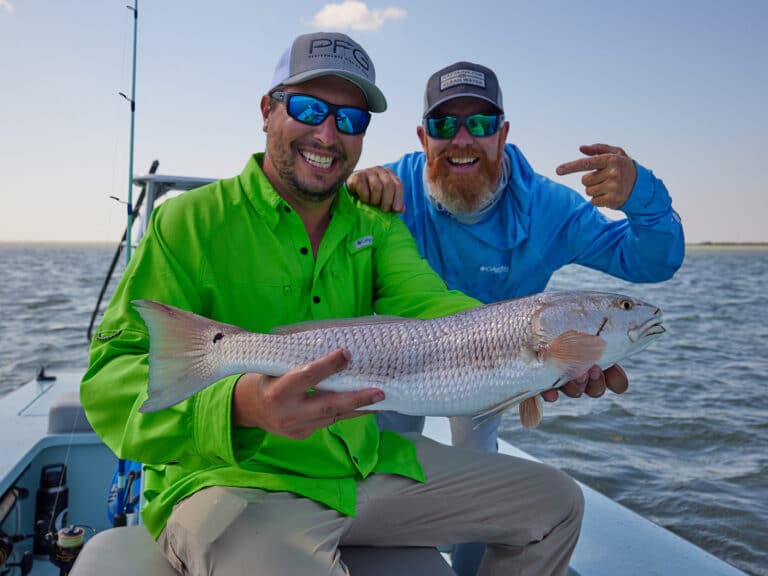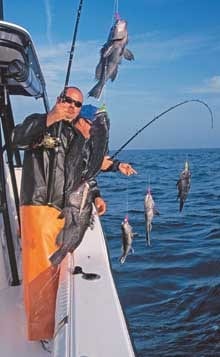
|| |—| || |Sea bass triple-headers help warm anglers up on a cold winter’s day.| Our first two drifts over a deepwater wreck 30 miles off Virginia Beach were uneventful, but when we drifted over the structure a third time, our luck changed. Bump, bump, bump, I felt a hefty fish hit one of the baits on my three-hook bottom rig. Bump, bump, bump, I felt another fish take another bait and telegraph his displeasure over 100 feet of braided line. Bump, bump, I felt a third fish on the line and started to crank against a triple-header of big fish each tugging and yanking in a different direction. I gritted my teeth and groaned against the weight of the fish while looking into the blue water anxious to see what would come up from the deep. I cranked and cranked only stopping when the fish strained against the drag. Then they appeared. Three dark spots became three black fish that turned into three big sea bass, each sporting a hump on top of its head. “Knotheads!” I yelled as I lifted the fish out of the water and swung them into the boat.
I looked around the cockpit to see my friends laboring on their own triple-headers of black sea bass. Soon, fish were swinging through the air and grown men were giggling like little kids.
Hot sea bass fishing keeps Mid-Atlantic anglers warm through the coldest time of year. Freezing temperatures and short days push the fish onto deepwater wrecks 30 to 50 miles off the coast. When the bass congregate offshore, hard-core fishermen bundle up in every piece of warm clothing they own and set out to find the knotheads.
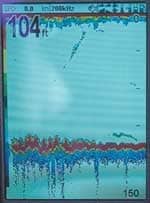
|A color fishfinder is a big help. Here, fish appear in green just off the bottom.|
Finding the Fish
The key to finding sea bass lies in finding the structure that they live on. Reese Bowles and his son Zach had invited Rick Williams, Tony James and me to join him on his 28-foot catamaran for a day of offshore sea bassing. We left Lynnhaven Inlet and turned East toward the Triangle Wrecks. After running for two hours, the GPS told us that we had reached the first wreck we would fish. Even the most accurate numbers will only get the boat in the neighborhood; it takes searching to find the fish.
Reese ran the boat around the area in ever-widening circles while watching the fish finder for signs of structure. Sometimes the fish will appear on the screen as a mound rising 30 feet off the wreck but this time they only showed up as a thin line scattered along the bottom.
At the first hint of life, Reese signaled Tony to throw over a buoy made out of a foam crab-pot marker, a length of line equal to the depth of the water, and a window sash weight to mark the location.
Once the buoy’s anchor settled on the bottom, Reese pulled the boat up to the marker and took it out of gear. As the boat drifted away, we dropped our rigs to the bottom. On the first drift, we didn’t catch anything.
Reese pulled the boat up to the right hand side of the marker and we dropped down again-nothing. As he pulled to the left of the buoy, we made another drop. Just as we drifted past the marker, everyone’s rod jerked down and bent over with the weight of several sea bass pulling at once. Each angler worked to haul his fish up from the wreck, then celebrated when he heaved a double or triple-header of writhing sea bass over the gunwale. From then on it was non-stop catching.
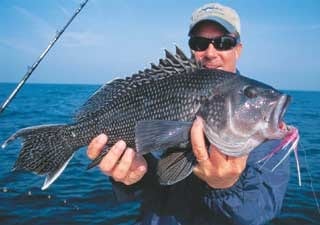
| |Reese Bowles shows off a sea bass that fell for a pink skirt and strip of squid.| As is often the case when fishing deepwater structure, a few feet can make the difference between fishing and catching. The buoy we threw out to mark the wreck was only a reference. Anglers must find the fish then note where the boat was in relation to the marker. The boat’s drift is adjusted to stay in the bite zone as current and wind direction shift throughout the day.
When our bite would slow, we would experiment with longer drifts and found that the fish were spread out around a site. I’ve seen small fish caught on one side of a wreck, and knotheads brought up from another side of the same structure. Sometimes, the fish bite better in the afternoon than during midday and at other times, the school will hold a few feet over the wreck.
We didn’t give up on a piece of structure just because it didn’t produce on the first few drops. The key is to adjust the drift until the fish are found, and then repeat the same drift time after time for as long as the bite lasts.
Secrets to Success
Although finding the fish can be a challenge, catching them is a blast. I’ve rarely met a sea bass that wasn’t hungry. At its minimum, sea bass fishing requires little more than a two-hook bottom rig, some chunks of squid, and a sinker. However, there are a few tricks that will put bigger fish in the box.
First, to increase the catch, increase the number of hooks on the bottom rig. Some anglers string as many as five hooks on a single rig, but this requires super heavy tackle and to hoist 20 pounds of bass up from the deep. I prefer to use a three-hook rig and a medium-heavy boat rod.
|| |—| |How To… Clean Fish with an Electric Fillet Knife When there is a pile of fish to clean, nothing cuts down the job like an electric fillet knife. Cleaning a fish with a motorized knife is as simple as one, two, three. First, cut through the shoulder of the fish to the backbone. Next, turn the knife and run it between the backbone and the meat. Leave a tag of skin connecting the fillet to the tail. Flip the fillet over and hold the fish by the head. Run the knife between the skin and the meat. Turn the fish over, and repeat the process on the other fillet. Cook Sea Bass I learned this recipe watching TV chef Emeril Lagasse. It is quick, easy, and tasty. Start with a hot frying pan (medium-high heat) with a couple of tablespoons of oil on the bottom. Dredge the boneless, skinless fish fillets in flour. Drop the fillets in the hot pan and sprinkle with salt and pepper. Add several Lagasse-sized dollops of real butter to the pan. After a couple minutes, flip the fillets. Cook a couple of minutes on this side until the fillets are firm and flakey – Bam!| The basic sea bass rig starts with a length of 50-pound-test monofilament. Tie five, six-inch surgeon’s loops in the line, each loop a little more than a foot apart. On the bottom loop, attach an eight-ounce sinker. Use a larger sinker in deeper water or when the current is ripping. To get the fish’s attention, slip a red bead and a pink or yellow bucktail hair skirt or plastic squid on each of the middle loops in front of a 3/0 hook. Clip the top loop of the rig onto a 100-pound-test snap swivel tied to the line running from the rod.
I use a sturdy boat rod and high-speed reel to hoist a brace of sea bass from the deep. The reel is spooled with 60-pound-test braided line, which greatly increases sensitivity while reducing the amount of weight needed to hold bottom. When using braided line, I can tell whether my sinker is hitting sand or hard structure and I can feel when a fish even breathes on my bait. However, braided line doesn’t stretch like monofilament so I use a rod with a softer tip that won’t yank the hook out of the fish’s mouth when I set up on it.
Squid is the most popular sea bass bait. It is cheap, readily available and sea bass love it. To clean the squid, first cut off the head and tentacles. Next, slice the body down the center and remove the goop inside and take out the piece of plastic-like backbone. After cleaning off the speckled skin, lay the meat flat, and cut it into one-inch by two-inch strips. Pierce the hook through the strip once at the wide end and let the rest of the bait dangle. Double hooking the strip or bunching it up will cause it to spin in the current. There is no need for a big gob of bait on the hook, just enough to get the fish hungry.
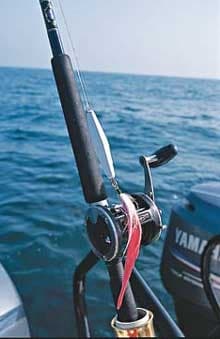
| |A diamond jig tipped with Fishbites proved to be sea bass killers.| Some of the best bait comes from the sea bass themselves. When our fish hit the deck they often coughed up the crabs that they were eating on the wreck. We scooped up the crustaceans and used them to catch the biggest sea bass of the day.
Another popular bait with serious seabassers is Fishbites – an artificial cut bait that comes in a variety of colors and scents. The stuff stays on the hook longer than natural bait. On one piece of Fishbites, I can catch a half dozen sea bass and the bait thieves have a harder time stealing it.
The first few fish we caught were small. “I know there are bigger fish down there,” Williams said, “we’ve got to get through the little guys.” He tied on a six-ounce diamond jig armed with a single hook and sweetened it with a strip of bait. I looked at him like he was crazy. Sea bass on a diamond jig? Yeah, right!
He dropped the jig to the wreck and put the reel in gear. Then he gave the rod an exaggerated jerk towards the sky. When his rod tip reached its apex, it was violently yanked back toward the ocean. Williams lifted the rod tip again and it doubled over against the pull of a big fish.
We watched as he fought the fish to the boat and then oohed with amazement when he lifted a big sea bass out of the water and dropped it into the box. Soon, we all tied on diamond jigs and started jigging up giant sea bass.
Eventually, we found a good concentration of big fish and returned to the three-hook bottom rig. Before long, we had enough sea bass for dinner, as well as breakfast and lunch. But mostly, we’d had more than enough fun for one day.
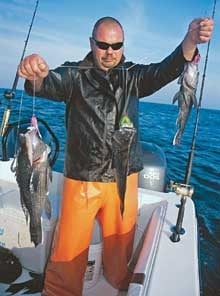
|
|On some days you’ve got to work through small fish to catch the bigger ones.|
Seasons of the Sea Bass
Williams looks for the sea bassing to heat up off Virginia Beach in September. The fish will gather on the Triangle Wrecks, Brass Spike and other mid-shore structure until the season closes December 1. In the dead of winter, the knotheads are stacked up on the few pieces of structure that lie the farthest offshore. When sea bass season reopens at the end of January, the 44 Fathom Wreck, Spring Chicken and Russian Trawler will hold hordes of big sea bass. In the spring, Williams returns to the mid-shore structures to catch the biggest bass from April until the end of May.
Sea bass follow the same migration pattern all along the Mid Atlantic Coast. Short days and cold water push the fish to the deepest water on the most remote wrecks and reefs. Anglers willing to make the long run to bluewater structure will be rewarded with limits of knotheads, many exceeding five pounds. In the middle of winter, freezing weather and hot fishing gets seabassers really excited.
| IF YOU GO SEA BASS REGULATIONS Virginia, Maryland, Delaware: Anglers may keep 25 sea bass larger than 12 inches. The season is closed from September 8 through 21 and December 1 through 31. These regulations are subject to change. Monitor each state’s website for updates: Virginia: www.mrc.state.va.us. Delaware: www.dnrec.state.de.us. Maryland: www.dnr.state.md.us. WRECK NUMBERS: Each state has published an artificial reef guide with GPS and Loran numbers for underwater structure lying off its coast. These guides are available by mail or online. The locations of other wrecks and reefs are marked on nautical charts such as those published by Captain Segull’s Nautical Sportfishing Charts. Visitwww.captainsegullcharts.com | Contacts: VIRGINIA Outfitters Lighthouse Tackle: (757) 318-3818 Ocean’s East II: (757) 464-6544 Charters Lynnhaven Seafood Marina Headboats: (757) 481-4545, www.fishingvabeach.com. Fisherman’s Wharf: (757) 428-2111 Virginia Beach Fishing Center: (800) 725-0509, www.virginiafishing.com. Paige II: Craig Paige, (757) 672-9381, www.fishpaige2.comTriple F Charters: Rob Wilhoite, (804) 730-6448 MARYLAND Outfitters Skip’s Bait and Tackle: (410) 289-8555, www.oceancityfishing.com Oyster Bay Tackle: (410) 524-3433, www.oysterbaytackle.com Charters Ocean City Fishing Center: (410) 213-1121, www.ocfishing.com DELAWARE Outfitters Lewes Harbor Marina: (302) 645-6227 Bill’s Sport Shop: (302) 645-7654, www.billssportshop.com Charters Karen Sue: John Nedelka, (302) 539-1359 |








